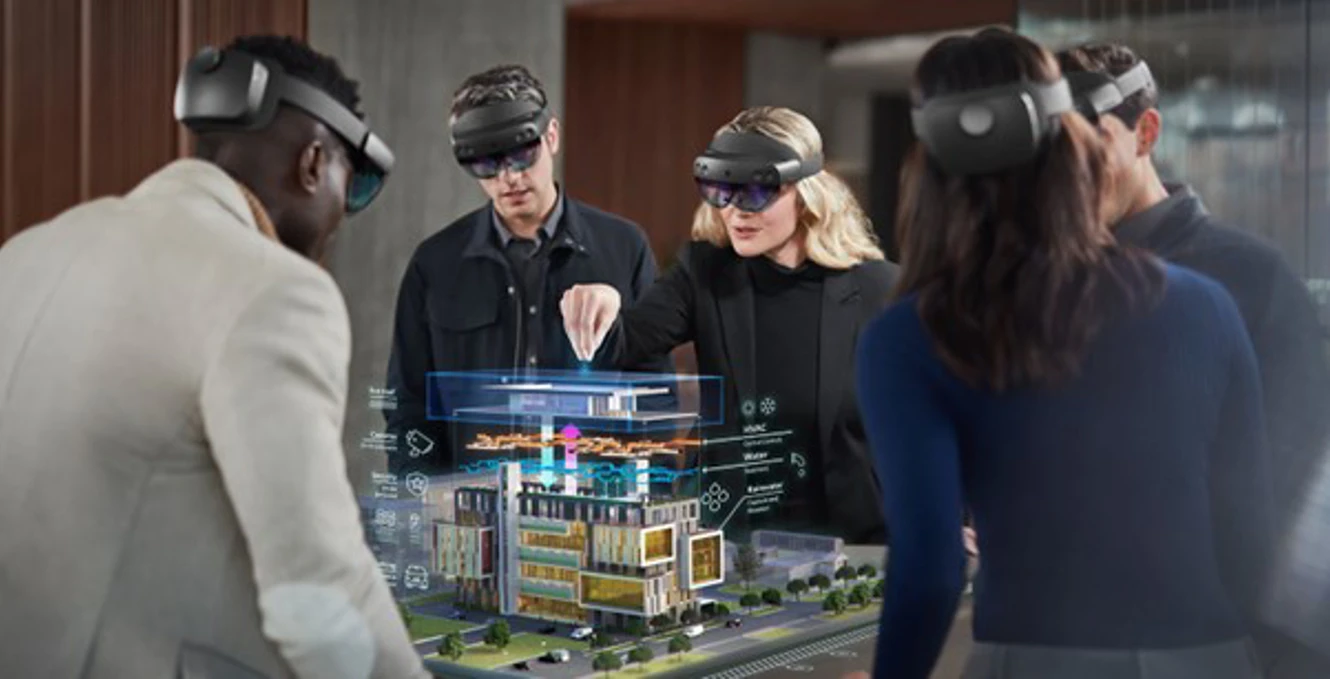How businesses are embracing virtual reality
7 ways businesses are using VR
There are many real-life scenarios where mixed reality (MR), augmented reality (AR), and virtual reality (VR) technologies are currently being used or have potential to be used in the future. Here are 7 examples:
1. Healthcare: VR/AR/MR can simulate real-life scenarios to provide hands-on training for students or employees, such as medical simulations for doctors or safety training for workers.
2. Architecture and Engineering: MR can be used to create 3D models of buildings or structures and allow architects and engineers to interact with the models in real-time.
Microsoft are investing heavily in healthcare applications for augmented reality for training, collaborative working, diagnostics and treatments
3. Entertainment : MR can be used in games, theme park attractions, and live events to create interactive experiences that combine the digital and physical worlds.
4. Retail : AR can be used to enhance the shopping experience by allowing customers to see how products will look in their homes before they buy them.
5. Education : AR can be used to provide interactive educational experiences, such as bringing textbook images to life or displaying 3D models.
6. Manufacturing : AR can assist workers in assembling complex products by overlaying instructions and diagrams on the actual physical object.
7. Estate Agents: VR can allow potential buyers to virtually tour homes, apartments or commercial properties, saving time and money on physical visits.
These are just a few examples of the many applications of MR, AR, and VR technologies in various industries. As the technology continues to advance, we can expect to see even more innovative uses in the future.
How about the future of training with MR, VR and AR?
The potential of training with mixed reality (MR), virtual reality (VR), and augmented reality (AR) is very promising. Meta Horizon Workrooms and Microsoft Mesh with Teams Avatars are very promising environments for MR/AR/VR training.
What is Microsoft Mesh?
Microsoft Mesh is a technology that facilitates shared holographic experiences for individuals in multiple physical locations. It can be combined with Microsoft Teams, enabling users to participate in virtual meetings, send messages, collaboration on shared documents, and more.
Key differentiators with Microsoft Mesh are the ability of users to create Avatars, and access shared experiences without the need for a headset. Users can join using a PC or mobile device.
Avatars: the face of virtual meetings
Avatars bridge the binary choice of users having their camera on or off in meetings due to video fatigue or just because they are wearing their pyjamas. Microsoft Teams Avatar builder provides an easy way to create and personalise multiple avatars, including reactions that can be used in meetings.
![]()
Potential ways in which these technologies could revolutionise training in the future include:
- Enhanced learning experiences: MR, VR, and AR can provide more immersive and interactive learning experiences than traditional classroom settings. These technologies can simulate real-life scenarios, allowing trainees to practice skills and make mistakes in a safe and controlled environment.
- Cost and time savings: MR, VR, and AR can save time and costs associated with traditional training methods, such as travel, equipment, and venue rental. These technologies can also enable trainers to efficiently provide remote training to trainees in different locations.
- Improved safety: MR, VR, and AR can provide realistic safety training simulations for high-risk jobs or emergency situations, allowing trainees to learn how to respond to potentially dangerous scenarios without putting themselves or others at risk.
- Personalised training: MR, VR, and AR can provide personalised training experiences by adapting to each trainee's individual needs and progress. These technologies can also collect data on trainee performance, allowing trainers to analyse and optimise training programs for maximum effectiveness.
- Continuous training: MR, VR, and AR can provide ongoing training opportunities for employees, allowing them to continually improve their skills and knowledge without taking time away from their work responsibilities.
However, as we have found at QA, with any technology there are risks. The potential risks with MR, VR and AR include:
- Health and safety: VR, MR, and AR can cause discomfort and nausea in some users, and there is a risk of injury if users are not careful while wearing the technology. It is recommended to only wear a VR headset for 30 minutes before having a break.
- Privacy and security: VR, MR, and AR can collect and transmit sensitive data, which can pose privacy and security risks if not properly managed.
- Cost and scalability: Developing and deploying VR, MR, and AR solutions can be costly, and it can be difficult to scale these solutions to meet the needs of large organisations. With VR, delegates and instructors will need the appropriate headset, license, account and setup. This can be a challenging barrier to overcome for adoption.
- Technical limitations: The technology behind VR, MR, and AR is still evolving, and there are limitations in terms of resolution, field of view, and specifically battery life that can impact the user experience.
- Acceptance and adoption : VR, MR, and AR are still relatively new technologies, and there may be resistance to adoption from customers and employees who are not familiar with the technology.
Overall, the future of training with MR, VR, and AR may be transformative. If the barriers and limitations can be overcome, these technologies can improve the quality, accessibility, and effectiveness of training, ultimately leading to better-trained employees and improved business outcomes.


